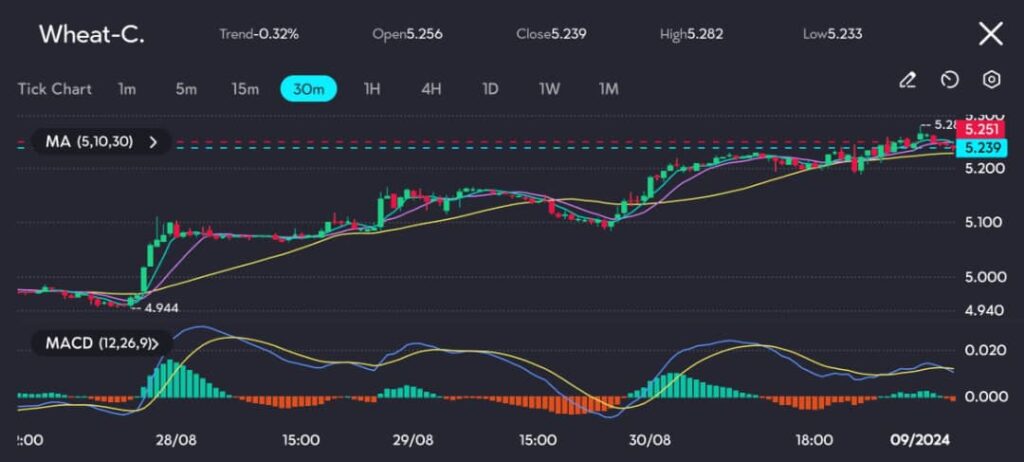Key points:
- Wheat futures rise for the fifth consecutive day due to poor European production.
- Soybeans and corn futures dip as attention shifts to ample global supply.
Chicago wheat futures edged higher on Tuesday, marking the fifth consecutive day of gains. The driving force behind this rally is the poor production outlook in Europe, which has helped lift wheat prices from nearly four-year lows.
Wheat gains 0.2% as supply concerns persist; corn and soybeans dip slightly
The most-active wheat contract on the Chicago Board of Trade (CBOT) (ZW1!) was up 0.2% at $5.52-3/4 a bushel as of 0058 GMT. This increase follows a 4.5% gain last week, reflecting how quickly the market has reacted to tightening supply prospects.
Meanwhile, CBOT corn (ZC1!) saw a slight decrease of 0.1% to $4.00-1/2 a bushel, and soybeans (ZS1!) slipped 0.1% to $9.98-3/4 a bushel. Despite these movements, all three contracts remain near their lowest levels since 2020, underlining the broader challenges facing agricultural commodities.

See: Wheat on the rise as seen on the VT Markets app.
The wheat market has been experiencing quite a bit of volatility, driven by recent developments in the European Union’s agricultural sector. The EU’s wheat harvest, particularly in France, is expected to be the worst in decades, a factor that has lent support to wheat prices. The European Commission has responded by cutting its estimate for usable EU common wheat production in the 2024/25 season from 120.8 million metric tons to 116.1 million tons. Additionally, the forecast for EU soft wheat exports has been lowered to 26 million tons from the previous 32 million tons.
This reduction in supply creates a more bullish environment for wheat prices. However, the market is facing strong competition from cheaper Black Sea grain, which complicates the outlook for traders. The mixed signals are reflected in the current chart, where wheat prices have shown a steady upward movement but face resistance near the $5.25 level.
The 30-minute chart above illustrates this recent price action. The moving averages (MA) suggest a bullish trend, with the short-term MA positioned above the long-term MA. However, the MACD histogram is showing signs of weakening momentum, indicating that the upward movement may be losing steam.
For traders, the key to navigating this market will be closely monitoring further developments in the EU’s wheat production and export policies, as well as keeping an eye on competition from Black Sea grain. While the short-term outlook for wheat prices remains somewhat positive due to supply constraints, the broader trend could be influenced by global market dynamics and trade flows.
The wheat market is a prime example of how agricultural commodities can be highly sensitive to regional developments, making it essential for traders to stay informed and adapt quickly to changing conditions.
Russian wheat forecast cut; Australia boosts production estimate
Further complicating the supply picture, Russian agricultural consultancy Sovecon lowered its forecast for Russia’s 2024 wheat crop to 82.5 million metric tons from 83.3 million.
While this is a decrease, the Russian crop remains large by historical standards, and other major producers like Canada, the United States, and Australia are expecting good harvests. On Tuesday, Australia even raised its wheat production estimate by 2.7 million tons, adding another layer of complexity to the global supply situation.
In other crops, U.S. export sales of corn and soybeans for the week ended August 22 exceeded analyst expectations, indicating robust demand. However, the Argentine corn planting area for the 2024/25 season is expected to drop by 17.1% year-on-year due to concerns over leafhopper pests and potential droughts, according to the Buenos Aires Grain Exchange (BdeC).
Recent rainfall in Argentina should help boost crops that are planted, though the overall outlook remains cautious.
Also read: Soybean, corn and wheat prices under pressure from supply increase
As these developments unfold, share markets have experienced slight declines, with investors bracing for a data-heavy week that will culminate in a U.S. jobs report. This report is expected to play a pivotal role in determining whether the Federal Reserve opts for a regular or more substantial interest rate cut later this month.
The agricultural market, much like the broader economy, remains highly sensitive to both supply disruptions and shifting demand dynamics.
Start trading now — click here to create your live VT Markets account.









